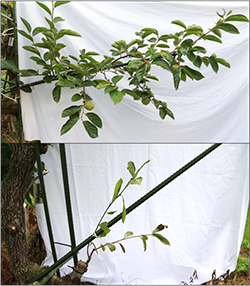National Agriculture and Food Research Organization (NARO) in collaboration with Ryukoku University has discovered that inbreeding affects various traits related to yield in persimmon breeding, thereby leading to yield reduction. In this research result, by estimating the degree of inbreeding based on genome information, it was revealed that the progress of inbreeding has a negative impact on important traits related to fruit yield, such as fruit weight and tree vigor. In the future, we will promote the development of high-yielding persimmon varieties by avoiding inbreeding based on genome information.
Overview
In order to revitalize the persimmon industry in Japan, NARO has been promoting breed improvement with the aim of producing delicious, attractive and high-yielding persimmons. Improvements have been made in terms of taste and appearance, but yield improvement is a major challenge now. Therefore, NARO is conducting research with the aim of improving persimmon yield.
It has been already known that inbreeding reduces fruit weight among the yield-related traits of persimmon. However, it was unclear how inbreeding affected various traits related to yield other than fruit weight (number of fruits, vigor, age of fruit-bearing trees, etc.).
Therefore, in collaboration with Ryukoku University, we implemented the double-digest restriction site-associated DNA sequencing (ddRAD-seq) method, which can analyze a large amount of genome information at high speed. By utilizing approximately 10,000 DNA markers obtained, we estimated the degree of inbreeding in cross combinations used in the past. We found that the closer the relative relationship between the parents, the lower the fruit weight, yield, and vigor of the tree, and the longer the fruit-bearing age. This suggests that as inbreeding progresses, low-yielding individuals increase.
In the future, by avoiding inbreeding based on genome information, we will efficiently promote the development of high-yielding, persimmon cultivars.

Normal persimmon (top) and persimmon
weakened by inbreeding (bottom)
(Both trees are 4 years old after grafting)
Publication
Inbreeding depression in yield-related traits revealed by high-throughput sequencing in hexaploid persimmon breeding populations. Noriyuki Onoue, Atsushi Kono, Akifumi Azuma, Ryusuke Matsuzaki, Atsushi J. Nagano, Akihiko Sato. Euphytica (2022)218:125
URL: https://doi.org/10.1007/s10681-022-03073-1
For Inquiries
Contact: https://www.naro.go.jp/english/inquiry/index.html




